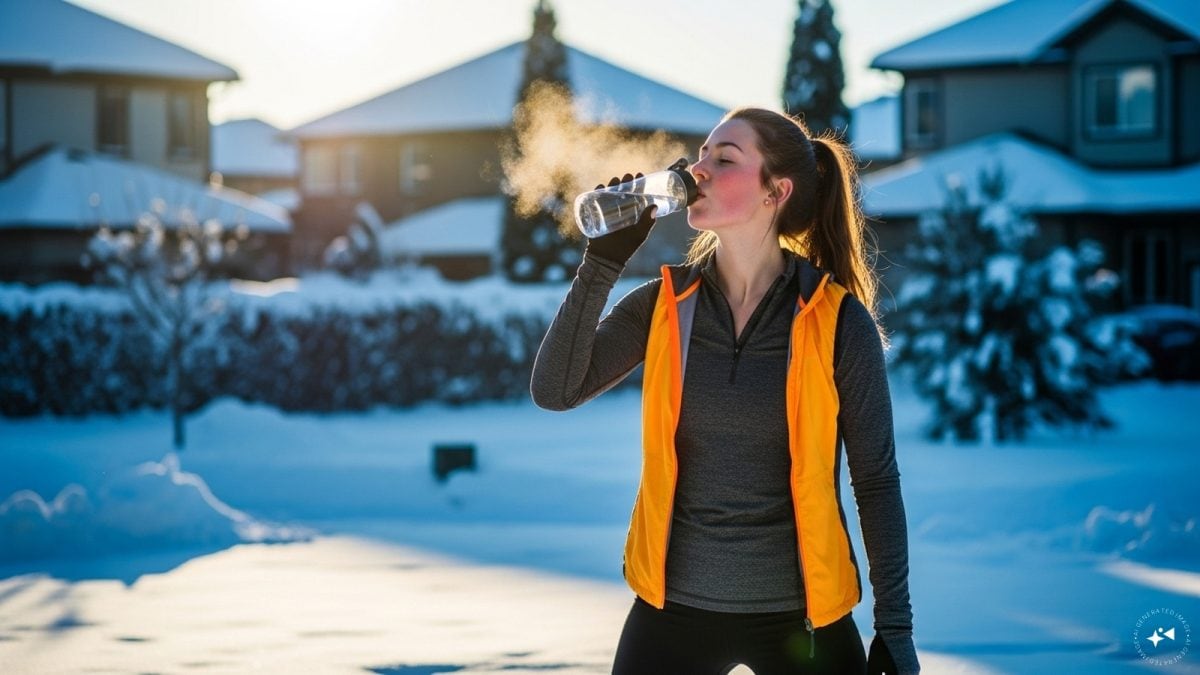Last Updated:
Research shows people drink nearly 40% less water in winter, even though the body still loses fluids through breathing and indoor heating

Outdoor workouts in winter can be deceptive. Because sweat evaporates quickly in dry, cold air, people underestimate their fluid loss (Image: Representational)
As temperatures begin to dip across India, our focus naturally shifts to keeping warm, layering up, sipping hot drinks, and cutting down on chilled water. But what often slips through the cracks is hydration. Remembering to drink enough water is easy during the summer when heat and sweat make it obvious. In winter, though, the body’s thirst signals tend to dull, even as it continues to lose fluids through breathing and everyday activity.
Research shows that dehydration is not just a summer concern. According to the European Hydration Institute, up to 60 per cent of adults are chronically dehydrated, and that rate barely changes with the seasons. During winter, we often underestimate our body’s fluid needs. The cold suppresses thirst, and we tend to drink less water.
Why Does Dehydration Happen in Winter?
Water accounts for about 60 per cent of body weight, playing a vital role in temperature regulation, metabolism, and nutrient transport. Even mild dehydration losing as little as 1 to 2% of body water can impair physical and cognitive performance.
In winter, fluid loss occurs through subtle yet constant mechanisms. The air indoors is dry due to central heating, pulling moisture from the skin and respiratory tract. When layered in thick clothing, the body continues to sweat, though we may not feel it because sweat evaporates faster in the dry air.
Additionally, cold weather reduces the body’s thirst response. A study from the Journal of Physiology (2014) found that cold exposure suppresses thirst by nearly 40%, even when the body is already mildly dehydrated. We lose water without realising it and without feeling the need to replenish it.
What Are the Main Causes of Winter Dehydration?
1. Indoor Heat and Dry Air
Central heating creates a comfortable environment but dries out the air. Spending long hours indoors means continuous exposure to this dryness, which accelerates fluid loss through the skin and breath. Over time, this contributes to fatigue, dry skin, and even nosebleeds.
2. Layering up in Winters
Bundling up in thick clothing traps heat and causes unnoticed sweating. Those who exercise outdoors often underestimate their sweat loss in winter, mistakenly believing cold air prevents dehydration. In reality, it only masks it.
3. Reduced Water Intake
In summer, carrying a water bottle is instinctive. In winter, it often feels unnecessary. Hot drinks like coffee or tea replace plain water, but both are mildly diuretic and can worsen dehydration if consumed in excess.
4. Cold-Induced Diuresis
The body responds to cold by constricting blood vessels to preserve warmth. This raises blood pressure, prompting the kidneys to excrete excess fluid—hence more frequent urination in winter. The result: subtle but steady dehydration.
What Are the Signs of Winter Dehydration?
The symptoms of dehydration in winter are often overlooked because they can mimic seasonal fatigue. Key signs include:
- Dry skin and lips
- Headaches
- Dizziness or confusion
- Dark urine
Fatigue: Even mild dehydration can trigger energy dips and sluggishness.
A meta-analysis of 33 studies published in Physiology & Behavior found that mild dehydration can impair concentration, mood, and motor coordination. This highlights how hydration affects not just physical health but also cognitive sharpness.
How Much Water Do We Actually Need?
According to the Institute of Medicine (IOM), women should consume around 2.7 litres of water per day and men around 3.7 litres. This includes water from food, which contributes roughly 20 per cent of total intake. For most adults, this translates to about 8 to 12 glasses of water daily.
However, water requirements vary depending on age, weight, activity level, and environment. Those who exercise outdoors, travel frequently, or work in heated indoor spaces may need more to maintain balance. The goal is not rigid adherence to a number but consistent, mindful hydration throughout the day.
How Can You Stay Hydrated During Winter?
- Keeping a refillable bottle within sight encourages frequent sipping. If you work from home, fill a jug or carafe and place it on your desk as a visual reminder.
- Drink warm water, caffeine-free herbal teas, or broths count towards your fluid intake and can be more appealing during cold weather. Studies show that temperature preference directly affects hydration behaviour, people tend to drink more when beverages match the climate.
- Eat water-rich foods like fruits such as oranges, apples, and strawberries, along with vegetables like cucumbers and celery, have high water content. Soups and stews are excellent options too, offering both hydration and nourishment.
- Track your daily hydration, you can try the “pee test” method. If urine is pale yellow, hydration is adequate. Dark yellow or amber suggests fluid deficit. Aim to check this a few times a day, especially after exercise or travel.
- Limit dehydrating beverages like alcohol and caffeinated drinks can increase water loss. For every cup of coffee or glass of wine, follow the 1:1 rule, drink an equal amount of water.
- Use hydration apps or smart bottles can send reminders throughout the day. This may sound unnecessary, but studies show that habitual cues visual or digital significantly improve hydration compliance.
Does Hydration Affect the Human Body in Winter?
Immune System
Winter often coincides with colds and flu, and hydration plays a role here too. Adequate fluid intake supports the immune system by maintaining mucous membrane integrity in the respiratory tract, which acts as a barrier against viruses.
A 2020 review in the Nutrients Journal emphasised that hydration is essential for immune cell transport and nutrient distribution. Simply put, staying hydrated helps your body fight infections more efficiently.
Physically
Outdoor workouts in winter can be deceptive. Because sweat evaporates quickly in dry, cold air, people underestimate their fluid loss. This can impair endurance, strength, and coordination.
The American College of Sports Medicine recommends drinking 400–800 ml of water before exercise and replenishing with at least 150–200 ml every 20 minutes during prolonged activity, regardless of temperature. Post-exercise hydration should replace 150 per cent of lost fluids to ensure recovery.
What Should You Do If You Suspect Dehydration?
If mild symptoms arise such as headache or fatigue, start by drinking water gradually rather than gulping large amounts at once. Add a pinch of salt or drink an oral rehydration solution to balance electrolytes. If dehydration becomes severe, with symptoms like confusion, rapid heartbeat, or fainting, medical attention is essential.
Older adults and young children are particularly vulnerable because their bodies retain less water and may not communicate thirst effectively.
Dehydration in winter is not a myth. It is a subtle, often overlooked health risk that affects energy, focus, and overall wellbeing. Cold weather dulls our thirst, while indoor heating, layered clothing, and reduced water intake quietly deplete body fluids.
October 25, 2025, 18:56 IST
Stay Ahead, Read Faster
Scan the QR code to download the News18 app and enjoy a seamless news experience anytime, anywhere.







